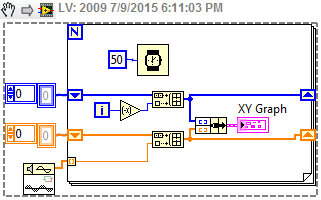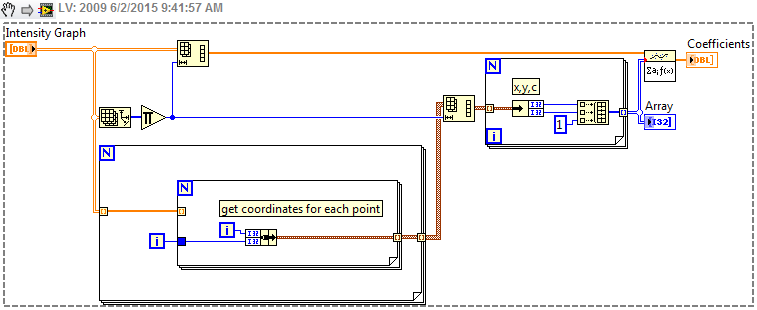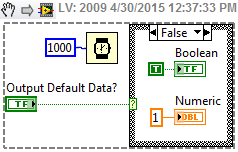
infinitenothing
Members-
Posts
372 -
Joined
-
Last visited
-
Days Won
16
Content Type
Profiles
Forums
Downloads
Gallery
Everything posted by infinitenothing
-
why so little love for statecharts
infinitenothing replied to MarkCG's topic in Application Design & Architecture
Primarily, $1555 -
"critical sections around shared resources" sounds a little like how non-reentrant VIs are used to arbitrate functional globals If I recall correctly, there's also some deadlock proofing in the DVRs where if you try and nest DVRs in a bad way you get an error. Just remember, you can't have it all https://en.wikipedia.org/wiki/CAP_theorem
-
-
Generate occurrence in FOR loop returns same reference
infinitenothing replied to eberaud's topic in LabVIEW General
It's probably not determined at compile time because I think reentrant clones will each have a unique number. It's probably determined when the VI is opened. -
Generate occurrence in FOR loop returns same reference
infinitenothing replied to eberaud's topic in LabVIEW General
The advantage there is you can open occurrences at will without worrying about closing, deleting, destroying, or releasing, your references -
How to correctly use the outputs of Gaussian Peak Fit?
infinitenothing replied to ThomasGutzler's topic in LabVIEW General
Someone should make a internet drop box type app for conversion. Until then, there's always http://forums.ni.com/t5/Version-Conversion/bd-p/VersionConversion. I've taken it back to 2009. -
AVI Write only saving first frame to file
infinitenothing replied to biomedoly's topic in Machine Vision and Imaging
Since you are storing the data uncompressed, maybe you can just write 2D arrays to disk using Write to Binary File -
What kind of throughput do you need? You could consider some sort of custom serial or parallel interface.
-
How to fit a 3D circular surface?
infinitenothing replied to Thang Nguyen's topic in Machine Vision and Imaging
That makes sense. Let me throw out an idea: So you're trying to find the coefficients in this formula: Z=a1x+a2y+C. You might be able to use this: http://zone.ni.com/reference/en-XX/help/371361H-01/gmath/general_ls_linear_fit/ Where Y is an array of all the pixel intensities and H is {x1,y1,c}, ... You might want to use real world coordinates instead of pixel coordinates. -
How to fit a 3D circular surface?
infinitenothing replied to Thang Nguyen's topic in Machine Vision and Imaging
A tilted circle projects to an ellipse right? http://zone.ni.com/reference/en-XX/help/370281M-01/imaqvision/imaq_fit_ellipse_2/ Not sure about the general solution but maybe something involving this solver http://zone.ni.com/reference/en-XX/help/371361J-01/gmath/find_all_minima_nd/ -
How to fit a 3D circular surface?
infinitenothing replied to Thang Nguyen's topic in Machine Vision and Imaging
You might have to show us some pictures. It sounded like you had some edge detection which should give you points that make a circle on the edge of the cylinder. You can use a circle fit to get the radius which will give you an area. If you need, you can take an average inside the circle to get the height of the cylinder. -
How to fit a 3D circular surface?
infinitenothing replied to Thang Nguyen's topic in Machine Vision and Imaging
Something like this?: http://zone.ni.com/reference/en-XX/help/370281P-01/imaqvision/imaq_fit_circle_2/ -
How should "Error In" affect code execution?
infinitenothing replied to JKSH's topic in LabVIEW General
Any sort of inter-module communication will have certain messages that you want to get across regardless of the error. -
How should "Error In" affect code execution?
infinitenothing replied to JKSH's topic in LabVIEW General
Relevant idea http://forums.ni.com/t5/LabVIEW-Idea-Exchange/Visual-indication-that-VI-will-run-even-on-error/idi-p/1587044 At the very least it should be in the context help when I hover over that terminal. -
.lvproj mutates on platform migration
infinitenothing replied to ensegre's topic in Source Code Control
Yeah, I've seen it mutate even without changing platforms. They are delicate. -
Why do these two subVIs behave differently?
infinitenothing replied to DTaylor's topic in LabVIEW General
I tried this in 8.6 and I got the same behavior. Not sure what's up with 2009. -
Why do these two subVIs behave differently?
infinitenothing replied to DTaylor's topic in LabVIEW General
I'm not sure where this is documented but it's pretty consistent. Here's a simplified diagram showing this behavior with a numeric. If you wire the indicators to the connector pane, they get defaulted at the end of the run. -
Why do these two subVIs behave differently?
infinitenothing replied to DTaylor's topic in LabVIEW General
The distinction was where they were implemented. If the memory is implemented higher up, its easier to unit test the lower level VIs. -
Why do these two subVIs behave differently?
infinitenothing replied to DTaylor's topic in LabVIEW General
No. Something happens after the false case runs. The VI returns default data for all its unwritten indicators. The moral of the story is to not use controls or indicators as memory storage. The preferred memory storage unit is a shift register in the test vi. A feedback node in the subVIs is the next best thing. -
Xmodem protocol using Hyperterminal
infinitenothing replied to Guruthilak's topic in LabVIEW General
Maybe explain how you fixed it for future visitors. https://xkcd.com/979/ You might phrase it differently. It's hard for us to think from the perspective of someone that's lost. -
Xmodem protocol using Hyperterminal
infinitenothing replied to Guruthilak's topic in LabVIEW General
Why? Doubtful. Did you try what I suggested above? -
Question about the JKI state machine
infinitenothing replied to eberaud's topic in Application Design & Architecture
And since you don't have type safety, if you have multiple state machine threads, you have to be careful to keep your queues straight and not send your message down the wrong pipe. -
Xmodem protocol using Hyperterminal
infinitenothing replied to Guruthilak's topic in LabVIEW General
Wait for a "C" from the receiver and then run "Xmodem Send.vi"





